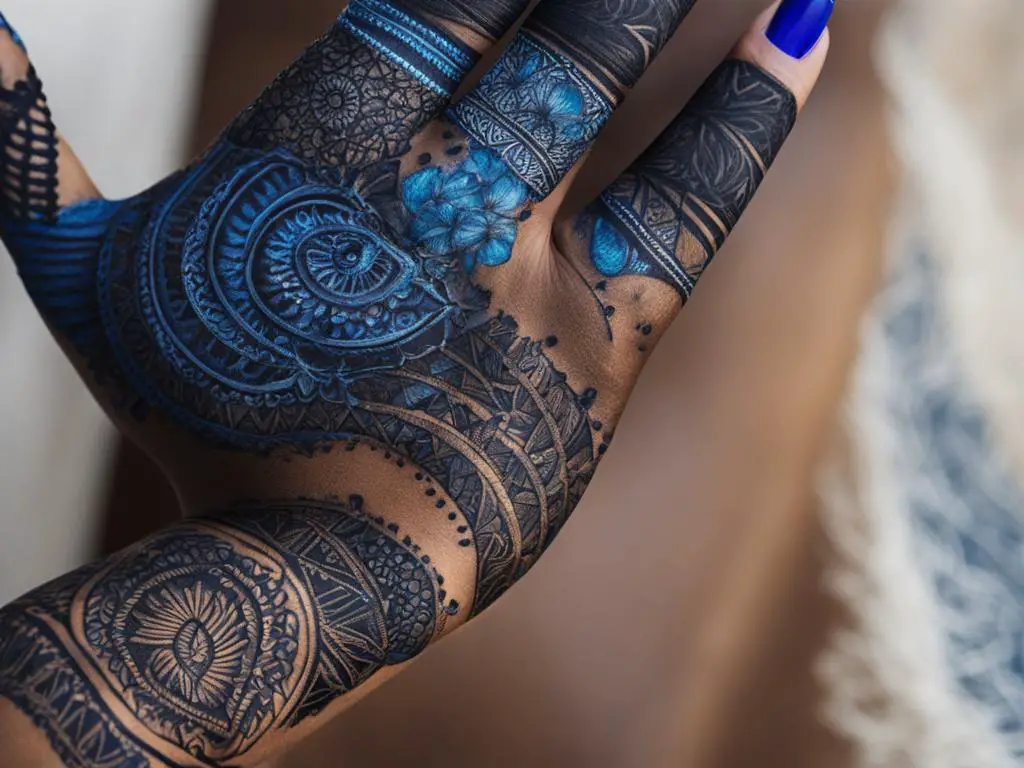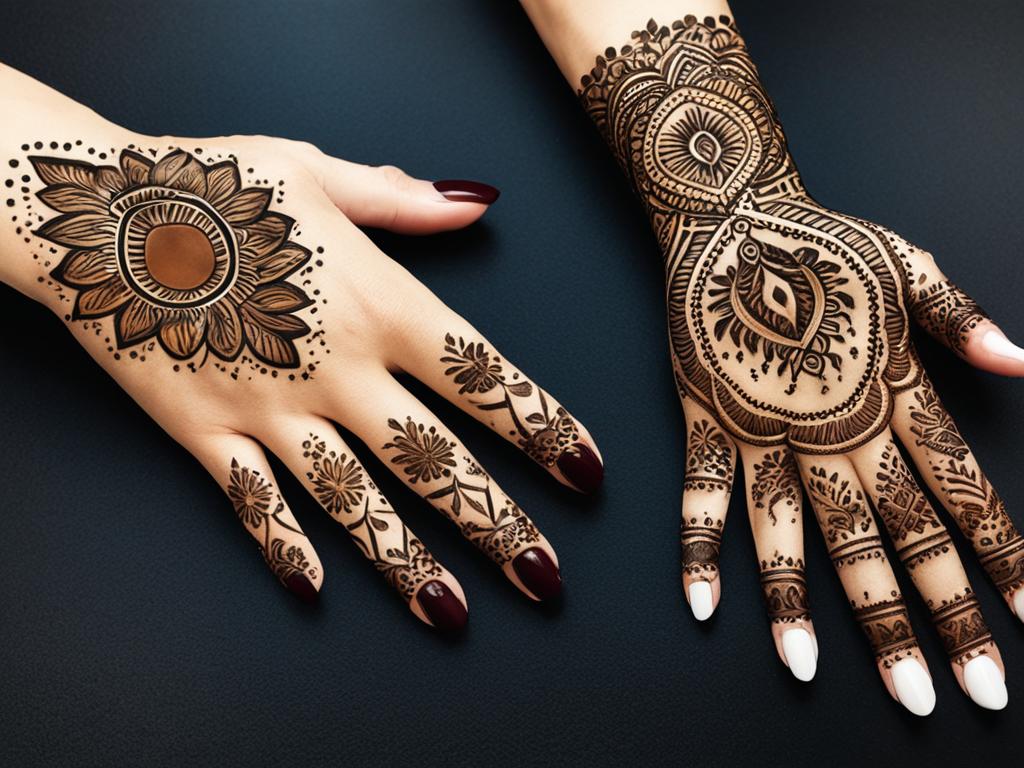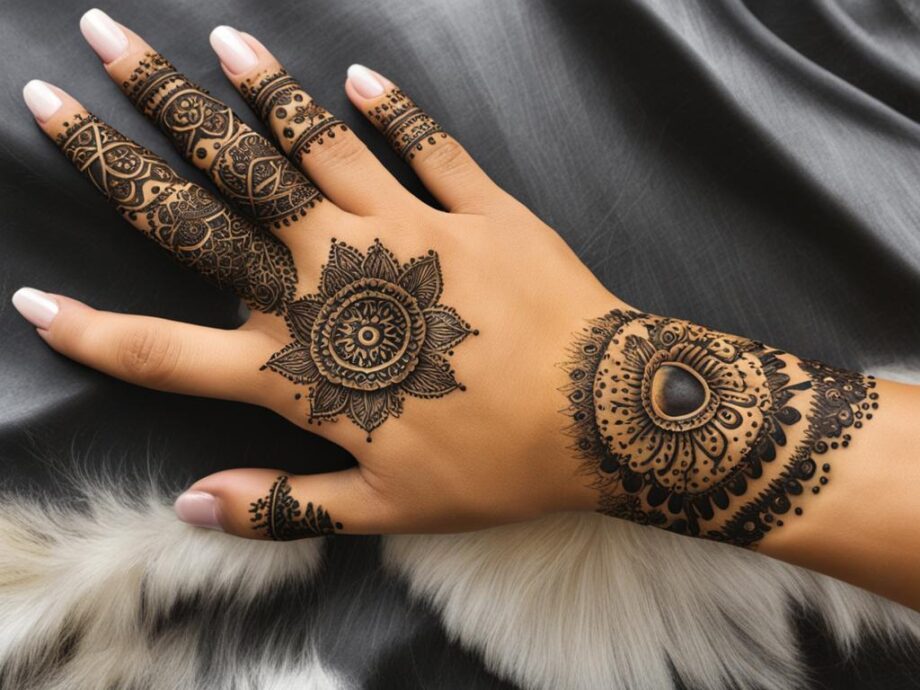When it comes to natural hair dye and temporary tattoos, two popular options are jagua gel and henna. While both are plant-based and offer unique benefits, there are differences to consider before choosing the best fit.
Jagua gel is known for its dark blue-black dye, resulting in a striking and long-lasting temporary tattoo. Henna, on the other hand, offers organic hair color and traditional mehndi designs, providing a deeper cultural significance to the body art.
In this article, we’ll explore the pros and cons of jagua gel vs henna. We’ll compare their colors, application methods, and lasting effects, and give insight into which natural option may work best for your preferences and needs.
Key Takeaways:
- Jagua gel and henna are natural options for temporary tattoos and hair dye.
- Jagua gel produces a dark blue-black dye, while henna offers organic hair color and traditional mehndi designs.
- There are pros and cons to both jagua gel and henna, such as lasting effects and application methods.
- Choosing the best natural body art option depends on personal preference and needs.
Understanding Jagua Gel
Jagua gel is a natural and safe alternative used for temporary tattoos and hair dye. It is derived from the unripe fruit of the Genipa Americana tree. The dye it produces is a dark blue-black color, which has quickly become a popular choice for body art enthusiasts.
When used for body art, jagua gel is applied to the skin, creating vibrant and bold designs. Its blue-black color is unique compared to traditional tattoo ink or henna. However, it is essential to note that the color of the jagua gel tattoo may vary, depending on the individual’s skin chemistry and the length of time the gel is left on the skin.

Jagua gel is also gaining traction as a natural hair dye alternative. It can be used to achieve a dark color that has blue undertones when applied to hair.
While jagua gel may be used safely, some potential drawbacks should be noted. People who are allergic to berries, such as strawberries or raspberries, may experience an allergic reaction to jagua gel. Additionally, jagua gel tattoos are not permanent and only last up to two weeks.
Exploring Henna for Natural Body Art
Henna is a plant-based dye that has been used for centuries to create intricate patterns on the body and hair. Originating from ancient Egypt and India, henna is celebrated for its versatility and natural composition.
As an organic hair color, henna is a popular choice for those looking to avoid traditional chemical dyes. It is known for its ability to enhance and enrich natural hair color, providing a shiny and lustrous look. Henna is also commonly used for traditional mehndi designs, which are applied to the hands, feet, and other parts of the body for cultural and ceremonial purposes.
One of the unique qualities of henna is its natural red-brown color, which can vary depending on the quality and composition of the henna powder. Some henna powders may have a more orangey or burgundy tone, while others will have a darker, almost black color.
When used as a body art medium, henna paste is created by mixing the henna powder with lemon juice, water, and essential oils. The paste is then applied to the skin and left to dry for several hours before being removed. The resulting tattoo will typically last for several weeks, gradually fading over time.
One limitation of henna for body art is that it can only produce shades of red-brown, so it may not be suitable for those seeking more vibrant or unique colors. It can also be difficult to achieve a consistent color and appearance, as the final result can be influenced by factors such as skin type, location on the body, and the quality of the henna powder.
Overall, henna offers a natural and versatile option for those looking for plant-based hair dye and temporary tattoos. Its traditional roots and organic composition make it a favorite among those seeking a more sustainable and mindful approach to beauty and body art.

Why Henna for Hair is a Healthy Choice
| Benefits of Henna for Hair | Drawbacks of Henna for Hair |
|---|---|
|
|
Using henna for hair coloring is a healthy and safe choice as it is free of chemicals and preservatives. Henna has natural conditioning properties that not only color the hair but also strengthen it. Unlike traditional dyes, henna deposits color onto the hair strands instead of penetrating them. This keeps the natural texture intact causing no damage to hair. It is also effective in balancing oil secretion and improving the scalp since it works as an antibacterial agent. However, henna can be somewhat tedious to apply and needs several applications for the color to deepen. It can also be messy and have unpredictable results on previously dyed hair or grey strands.
Comparing Jagua Gel and Henna
Both jagua gel and henna are popular natural options for temporary tattoos and hair dye. While they share commonalities, they also have distinct differences. Let’s take a closer look at the factors to consider when comparing jagua gel and henna.
Colors
Jagua gel is known for its striking dark blue-black dye, which is particularly impactful on lighter skin tones. Henna, on the other hand, offers a range of reddish-brown hues that deepen with time. Ultimately, the color preference is a matter of personal taste and skin tone compatibility.
Application Processes
Both jagua gel and henna require preparation before application. Jagua gel must be stored in the freezer, thawed before use, and kept warm during application. It also needs to be left on the skin for a longer period to achieve the desired stain. Henna, on the other hand, requires mixing with a liquid and a few hours to release its dye before application. Additionally, the paste needs to be left on the skin for several hours to allow for saturation.
Lasting Effects
Jagua gel tends to last longer than henna, typically up to two weeks for tattoos and up to six weeks for hair dye. However, jagua gel’s color can fade faster if applied to overly oily or damp skin. On the other hand, henna tattoos can last up to two weeks on the skin and up to four weeks on hair, but they tend to fade gradually, losing intensity over time.
Overall Experience
The overall experience of using jagua gel and henna is different. Jagua gel may cause a mild stinging sensation when applied, but it typically does not have an odor and dries quickly. Henna, on the other hand, has a distinctive earthy scent and can leave a slight residue on the skin after application. The intricate patterns of henna designs often make the application process more time-consuming than jagua gel.
Ultimately, the differences between jagua gel and henna come down to personal preferences. If bold color and lasting effects are a priority, jagua gel may be the better option. If a wider range of color and a traditional application process are desired, henna may be the way to go.

Conclusion
In conclusion, both jagua gel and henna offer unique and natural options for temporary tattoos and hair dye. Jagua gel offers a dark blue-black dye and a shorter application time, while henna provides organic hair color and a traditional mehndi design for body art.
When deciding between jagua gel vs henna, it ultimately comes down to personal preference and individual needs. Those seeking a bolder and darker temporary tattoo may prefer jagua gel, while those looking for a plant-based and organic option may opt for henna.
It’s worth noting that like any natural dye or product, there may be limitations or potential drawbacks. It’s essential to do research and patch tests before using jagua gel or henna on the skin or hair.
Overall, jagua gel and henna offer exciting and natural alternatives to traditional body art options. By understanding the differences and benefits of each, readers can make informed decisions and enjoy the unique beauty and expression that natural body art provides.
FAQ
Is jagua gel a natural hair dye?
Yes, jagua gel is a natural hair dye derived from the jagua fruit. It is often used to achieve a dark blue-black color for temporary hair dyeing.
Can henna be used for body art other than hair dyeing?
Absolutely! Henna is not only used for organic hair coloring but also for traditional mehndi designs on the skin. It is a versatile plant-based dye that can create beautiful temporary tattoos as well.
What are the pros of using jagua gel for body art?
Some of the advantages of using jagua gel for body art include its dark blue-black dye color, long-lasting effects, and ease of application. It is a popular choice for those seeking a unique and eye-catching temporary tattoo or hair dye.
Are there any drawbacks to using henna for body art?
While henna is generally safe to use, it can cause allergies or sensitivities in some individuals. Additionally, the color outcome may vary depending on individual hair or skin type. It is recommended to do a patch test before using henna extensively.
How do jagua gel and henna compare in terms of application methods?
Both jagua gel and henna require a similar application process. They are typically applied to the skin or hair using cones, tubes, or brushes. However, jagua gel may require a longer drying time compared to henna.
Do jagua gel and henna have any lasting effects on the skin or hair?
Yes, both jagua gel and henna leave temporary stains on the skin and hair. The intensity of the color and duration of the effect may vary depending on individual skin type, hair texture, and aftercare.
How can I decide between jagua gel and henna for body art?
Choosing between jagua gel and henna for body art depends on personal preferences and the desired outcome. If you aim for a dark blue-black color, jagua gel may be the better option. If you prefer a reddish-brown hue and admire traditional designs, henna is a great choice. It’s always a good idea to do a patch test and experiment with small areas before committing to a larger tattoo or hair dye application.
